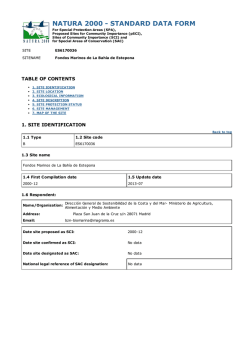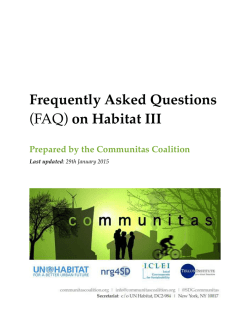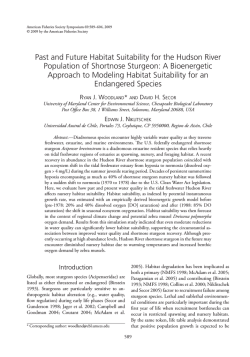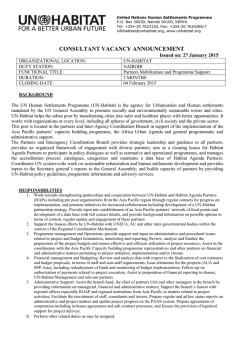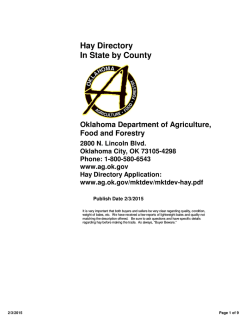
upland hay meadows - Scottish Natural Heritage
UPLAND HAY MEADOWS (UK BAP PRIORITY HABITAT) Summary This is a type of unimproved grassland found on well-drained neutral soils in upland areas of northern Britain, especially in the north Pennines but also widely in Scotland. The habitat equates with the NVC community MG3. Amongst the grassy swards is a distinctive abundance of herbs. In Scotland most examples are small patches on roadside verges, riverbanks and hill slopes, but some occurrences are in enclosed fields within upland areas (as seen more commonly among the English examples of this priority habitat). The flora can include notable concentrations of uncommon or local mesotrophic herbs. The vegetation is also an important food source for grazing mammals, invertebrates and birds. The Upland hay meadows habitat is maintained by a combination of grazing and mowing without which the vegetation would eventually develop into woodland. Ploughing, re-seeding and treeplanting can convert Upland hay meadows into other habitats of lower conservation value. What is it? This is a type of unimproved grassland found on well-drained neutral soils in upland areas of northern Britain. The grass swards are made up mainly of red fescue Festuca rubra, Yorkshire-fog Holcus lanatus, common bent Agrostis capillaris, sweet vernal-grass Anthoxanthum odoratum, crested dog’s-tail Cynosurus cristatus and rough meadow-grass Poa trivialis. Most distinctive is the abundance of wood crane’s-bill Geranium sylvaticum, but other herbs are common too, including ribwort plantain Plantago lanceolata, meadow buttercup Ranunculus acris, bulbous buttercup R. bulbosus, smooth lady’s-mantle Alchemilla glabra and common sorrel Rumex acetosa. Some forms of MG3 are semi-improved, with a flora including perennial rye-grass Lolium perenne and soft brome Bromus hordeaceus (MG3a). Others are taller (less grazed), with false oat-grass Arrhenatherum elatius and cock’s-foot Dactylis glomerata (MG3c). The remainder (MG3b) are generally medium height, with less Arrhenatherum, Dactylis and Lolium, so they lack signs of agricultural improvement and can be species-rich. This type of grassland can have notable concentrations of mesotrophic herbs such as Ranunculus bulbosus, yellow-rattle Rhinanthus minor and some species less common nationally including wood crane’s-bill Geranium sylvaticum, globeflower Trollius europaeus, melancholy thistle Cirsium heterophyllum, northern marsh-orchid Dactylorhiza purpurella, common twayblade Listera ovata, butterfly orchids Platanthera spp. and, in northern England and southern Scotland, great burnet Sanguisorba officinalis. In Scotland most MG3 occurs as small patches on roadside verges, riverbanks and hill slopes, but some occurrences are in enclosed fields within upland areas. The community also occurs in northern England, where many examples are in enclosed fields in upland areas, especially the northern Pennines. The flora of the English MG3 is similar to that in the Scottish examples, but many English examples include Sanguisorba officinalis. How do I recognise it? Differentiation from other Priority Habitats This is one of the most clearly defined priority habitats and therefore one of the least likely to be confused with any other. The reason for this is that it corresponds exactly with one NVC community: MG3 Anthoxanthum odoratum-Geranium sylvaticum grassland. No other priority habitat includes MG3, and no other type of vegetation is included within this Upland hay meadows habitat. MG3 is a distinctive community in containing an abundance of Geranium sylvaticum, so confusion with other neutral grasslands (some of which belong in the Lowland meadows priority habitat) is unlikely. Some herb-rich forms of U4 Festuca-Agrostis-Galium grassland in the Highlands contain G. sylvaticum, but differ from MG3 in having more tormentil Potentilla erecta and heath bedstraw Galium saxatile, and larger quantities of mosses such as Rhytidiadelphus squarrosus, Hylocomium splendens, Pleurozium schreberi and Scleropodium purum. Definition in relation to other habitat classifications Classification NVC Phase 1 UK BAP broad habitat Habitat types belonging to this UK BAP priority habitat MG3 (all examples). (MG3 is included in the Scottish Biodiversity List.) B2 (all examples which belong to NVC community MG3). All examples of this priority habitat which conform to NVC community MG3 belong in the broad habitat - Neutral grassland. Definition in relation to legislative classifications Classification Habitats Directive Annex I SNH SSSI habitat features Habitat types belonging to this UK BAP priority habitat H6520 (all occurrences). Lowland neutral grassland SSSI feature type (all of the Upland hay meadows component (i.e. NVC MG3)) of this SSSI habitat feature belongs in this priority habitat. Where is it? This priority habitat occurs on well-drained neutral soils on level to moderately sloping ground in upland parts of Britain. Some examples occupy entire fields, but these are mainly in northern England. In Scotland there are a few fields of MG3 or mosaics of MG3 and other types of grassland, but most Scottish examples of this NVC community are smaller, irregularly scattered patches on roadside verges, by rivers and streams, and scattered among interesting and diverse mosaics of grassland, wetland, woodland and scrub on hill slopes at low to moderate altitudes. In these latter habitats the Upland hay meadows are typically associated with other priority habitats such as Upland calcareous grassland, Upland flushes, fens and swamps, Upland mixed ashwoods and Wet woodland. This is an uncommon habitat in Britain. MG3 grasslands are scattered widely but very thinly through that part of northern Britain in which wood crane’s-bill Geranium sylvaticum grows: from the central Pennines northwards but rare in the extreme west and the far north. The greatest concentration of MG3 grasslands is in the north Pennines, but there are scattered records northwards through the eastern half of the Southern Uplands, in the Central Belt and in the southern half of the Highlands. Their total extent in Scotland has been estimated to be less than 70 hectares (Ellis and Munro 2004); this compares with up to 1000 hectares in northern England (UK BAP 2008). Broadly similar grasslands exist in the Faroes and on the European mainland. What is special about it? As with Lowland meadows, Upland hay meadows are valuable as surviving remnants of a previously much greater extent of unimproved herb-rich neutral grassland. The flowering plants here are a valuable nectar source for insects. Some species of special conservation status recorded in this priority habitat in Scotland are listed below. Group bird bird bird bird bird bird bird butterfly butterfly butterfly bee flow ering plant flow ering plant mammal Com mon nam e kestrel grey partridge lapw ing skylark linnet tw ite hooded crow small heath northern brow n argus marsh fritillary great yellow bumblebee lesser butterfly orchid greater butterfly orchid brow n hare Latin nam e Falco tinnunculus Perdix perdix Vanellus vanellus Alauda arvensis Cardeulis cannabina Cardeulis flavirostris Corvus cornix Coenonympha pamphilus Aricia artaxerxes Euphydryas aurinia Bombus distinguendus Platanthera bifolia y Scottish Biodiversity List y y y y y y y y y y UK BAP priority list y y y y y y Platanthera chlorantha Lepus europaeus EC Habitats Directive Annex II y y Red Data List y y y y y Wildlife and Countryside Act (1981) y y y y y y y y y y y How do we manage it? Within the main British concentration of the Upland hay meadows habitat – the north Pennines – many examples are maintained by traditional hay meadow management: ungrazed through spring and early summer, mown for hay in late summer and grazed in autumn and winter. Some Scottish examples are managed similarly but others, especially where the MG3 occurs in mixed habitat mosaics, are subject to various systems of grazing or mowing which may not be carried out specifically with the MG3 habitat in mind. In these latter places the larger scale management of various habitats including MG3 has happened to include an element of grazing or mowing which has fortunately allowed the MG3 to survive. Without some kind of grazing or mowing the MG3 vegetation would develop firstly into a coarser and less species-rich type of neutral grassland (more like the MG1 community), with subsequent colonization by trees and shrubs so as to eventually become woodland (probably of the W7 or W9 NVC communities). Good management for conservation includes avoidance of ploughing, re-seeding and treeplanting, all of which are detrimental to the maintenance of the Upland hay meadows habitat. With ideal management there is little or no treatment with artificial fertilisers because these can encourage species such as perennial rye-grass Lolium perenne, soft brome Bromus hordeaceus and white clover Trifolium repens at the expense of other herbs (as seen in the MG3a sub-community). Where fertiliser is applied it is best if this is restricted to no more than a very light application of manure or lime which the richer MG3b flora appears able to tolerate, at least in northern England. References, links and further reading Averis, A., Averis, B., Birks, J., Horsfield, D., Thompson, D., & Yeo, M. 2004. An Illustrated Guide to British Upland Vegetation. Peterborough, JNCC http://jncc.defra.gov.uk/page-2463 Ellis, N.E. and Munro, K. 2004. A preliminary review of the distribution and extent of BAP priority habitats across Scotland. Scottish Natural Heritage Commissioned Report No.044 (ROAME No. F00NA02). http://www.snh.org.uk/pdfs/publications/commissioned_reports/F00NA02.pdf MacKintosh, J., Hawker, D., Munro, K. & Smith, M. 2004. The distribution and extent of lowland grassland National Vegetation Classification (NVC) types and Biodiversity Action Plan (BAP) habitats in Scotland. Scottish Natural Heritage Commissioned Report No. 009 (ROAME No. F97AA100). http://www.snh.org.uk/pdfs/publications/commissioned_reports/F97AA100.pdf Rodwell, J.S., ed. 1991a British plant communities Volume 3: Grasslands and montane communities. Cambridge, Cambridge University Press. Rodwell, J.S., Dring, J.C., Averis, A.B.G., Proctor, M.C.F., Malloch, A.J.C., Schaminee, J.H.J. & Dargie, T.C.D. 1998. Review of coverage of the National Vegetation Classification. Joint Nature Conservation Committee contract report F76-01-170. Coordinated by the Unit of Vegetation Science, Lancaster University. UK BAP 2008. http://jncc.defra.gov.uk/pdf/UKBAP_BAPHabitats-60-UplandHayMeadows.pdf Usher, M.B., Bain, C. and Kerr, A. eds. 2000. Action for Scotland's Biodiversity. Scottish Biodiversity Group. Edinburgh, The Scottish Executive and The Stationery Office. Common Standards Monitoring guidance http://www.jncc.gov.uk/page-2199 Countryside Survey: http://www.countrysidesurvey.org.uk National Biodiversity Network (NBN) Gateway https://data.nbn.org.uk/ Scottish Natural Heritage website: http://www.snh.gov.uk/ UK BAP information on JNCC website: http://jncc.defra.gov.uk/default.aspx?page=5155
© Copyright 2025
